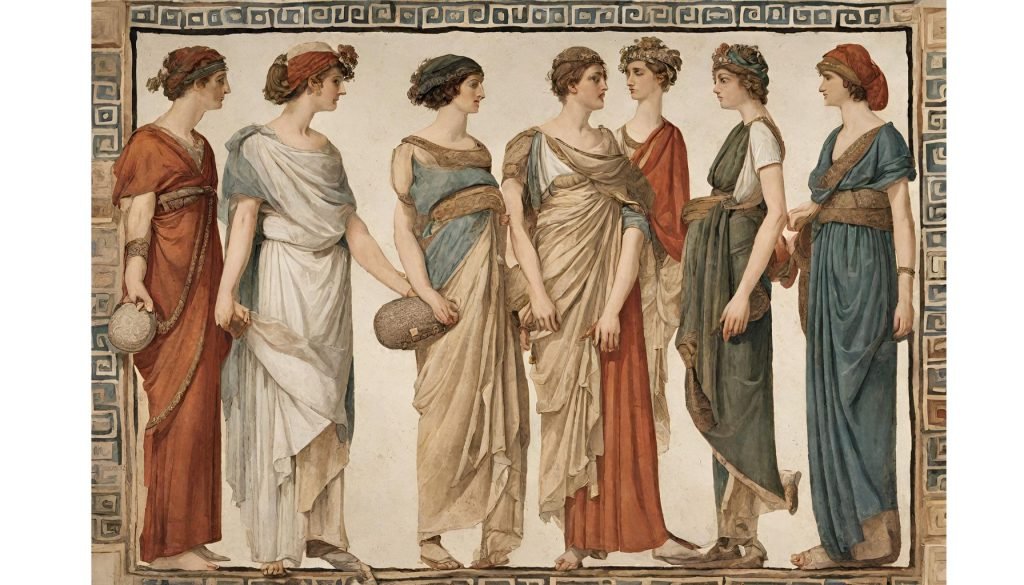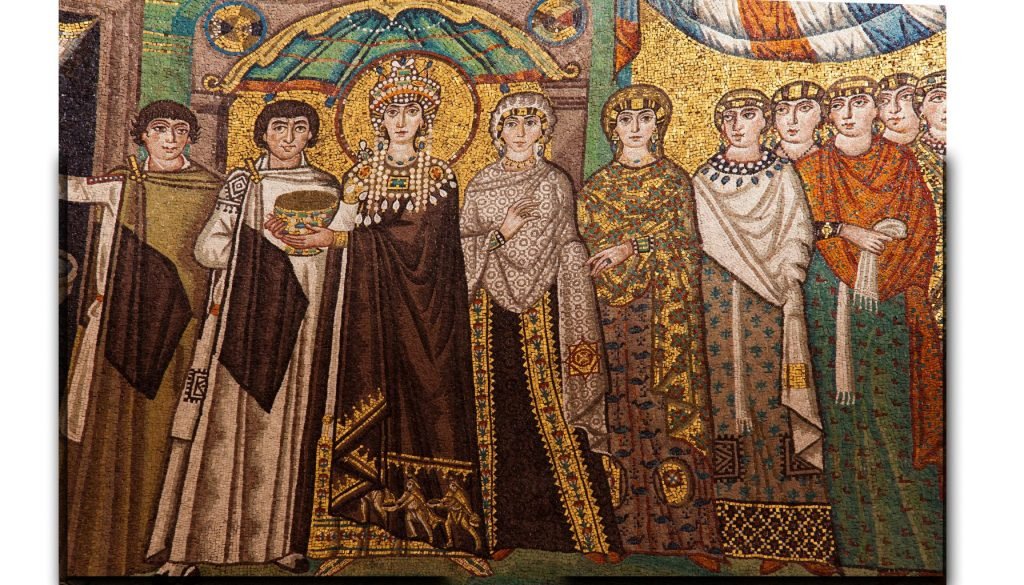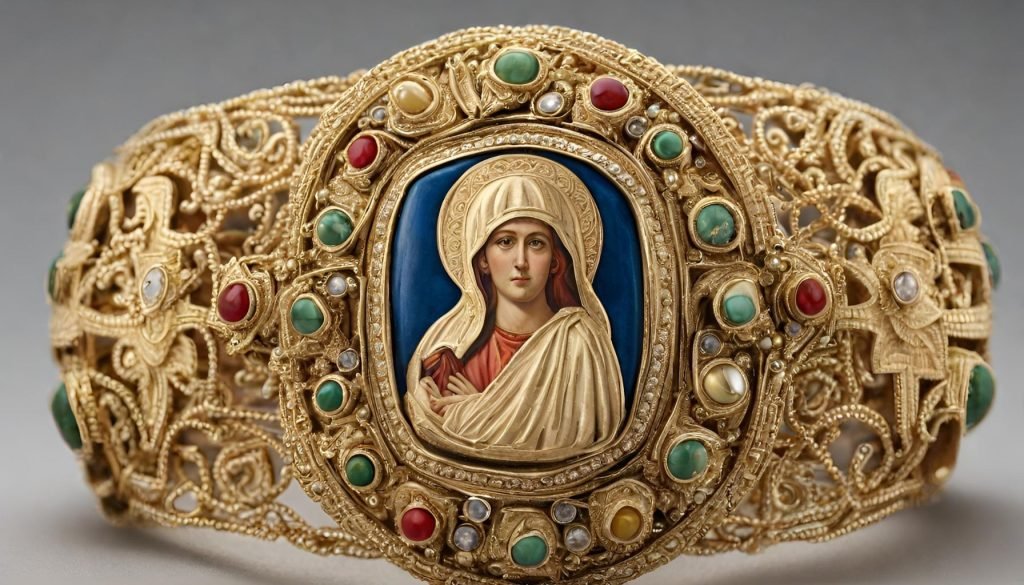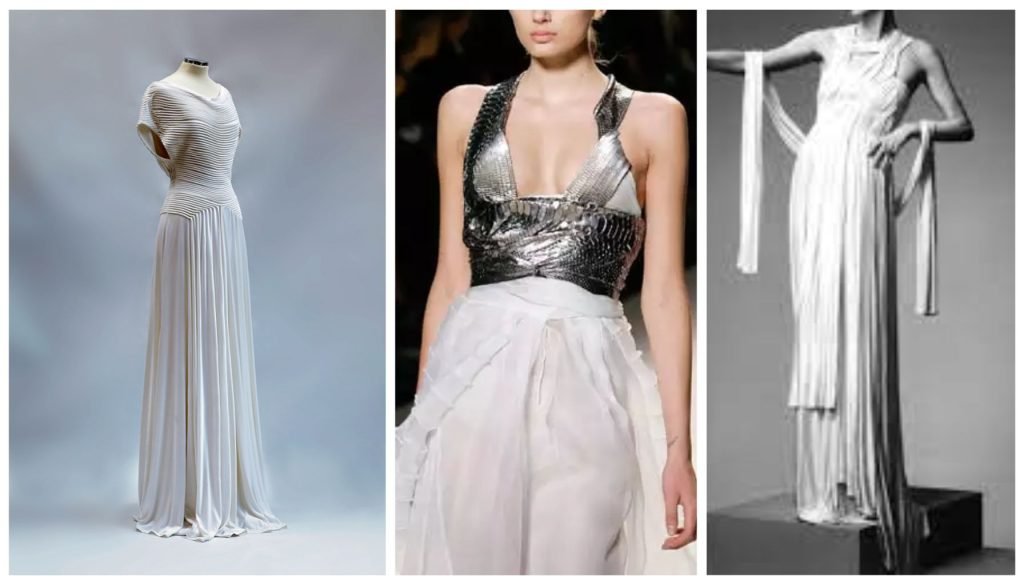- March 30, 2024
- fashionads@sxediomodas.com
- (0)
- Global Fashion
Table of Contents
Draped in History: The Evolution of Greek Fashion from the Gods to the Runways
From the draped linens of ancient deities to the chic runways of Athens, the story of Greek fashion is as intricate and evolving as the history of Greece itself. Spanning millennia, the evolution of Greek attire offers a unique window into the cultural, political, and social shifts that have shaped not only a nation but also the wider Western civilization. Greek fashion, with its hallmark simplicity, elegance, and fluidity, has transcended its geographical origins to leave an indelible mark on global style trends.
This article, “Weaving Through Time: The Tapestry of Greek Fashion from Antiquity to Modernity,” embarks on a sartorial journey tracing the threads of Greek fashion from the folds of the ancient chiton to the bold lines of contemporary design. It is a narrative that unfolds through the ages, revealing how fabric and fashion have been central to expressing identity, status, and beauty within Greek culture. As we explore the transformation of Greek attire, we will discover the enduring legacy of ancient styles, the influence of successive periods of foreign rule, and the resurgence of Greek creativity in the modern fashion world.
Moreover, we will shine a spotlight on the designers who have woven their unique threads into the fabric of Greek and global fashion, influencing trends far beyond the Mediterranean shores. From the timeless elegance of ancient Greece to the innovative spirit of today’s fashion scene, Greek fashion continues to enchant with its blend of history, artistry, and modernity.
Join us as we traverse the ages, exploring the rich tapestry of Greek fashion—a journey that mirrors the dynamism of Greek culture and its lasting impact on the world. Through this exploration, we aim to celebrate not just the garments but the stories they tell, the people they adorn, and the hands that crafted them, stitching together a narrative as compelling as the history of Greece itself.
Ancient Beginnings (up to 146 BC)
The fabric of Greek society, quite literally woven into its history, reveals much about the ancient world’s intricacies. Greek attire in the period up to 146 BC, a time of philosophers, warriors, and gods, was marked by its simplicity, functionality, and aesthetic appeal. This section delves into the seminal garments of ancient Greece, the materials used, and the societal roles they played, laying the foundation for fashion’s enduring journey through time.
Chitons and Peplos
Central to ancient Greek wardrobe were the chiton and peplos, garments that showcased the Greek mastery of drapery and the art of dressing with elegance and ease. The chiton, a unisex garment, was essentially a rectangular piece of cloth secured at the shoulders and belted at the waist, allowing for varied lengths and styles. Women often wore the peplos, a heavier woolen garment, creating a blouse-like effect over the waistline, offering both warmth and modesty. These garments, primarily made from wool or linen, reflected the wearer’s status and the occasion, with variations in fabric, color, and decoration.
Himation and Chlamys
As outerwear, the himation and chlamys offered warmth and protection while adding layers to the ensemble. The himation, a large cloak worn over the chiton, was draped elegantly around the body, often serving as a blanket or bedding during travel. The chlamys, a shorter cloak fastened at the right shoulder, was typically worn by men, especially soldiers and young men, symbolizing action and mobility. These pieces not only provided practical benefits but also contributed to the aesthetic allure, allowing individuals to express their identity and social standing.
Accessories and Jewelry
Accessories played a significant role in ancient Greek fashion, with jewelry, footwear, and headgear adding personal touches to the ensemble. Jewelry, crafted from gold, silver, and precious stones, adorned both men and women, signifying wealth and status. Intricately designed necklaces, bracelets, and earrings were common, along with hairpins and brooches used to secure garments. Footwear, varying from simple sandals to intricately designed boots, was tailored to the occasion, activity, or status of the wearer. Crowns, wreaths, and headbands, often made of metal or foliage, were worn for special occasions and religious ceremonies, symbolizing honor and divine favor.

This foundational era of Greek fashion not only defines the aesthetics of the ancient world but also lays the groundwork for understanding how attire reflects broader societal values, beliefs, and practices. The simplicity, versatility, and beauty of ancient Greek garments have left a lasting legacy, influencing fashion trends and designers for centuries to come.
Byzantine Influence (330 AD – 1453 AD)
The Byzantine Empire, known for its rich tapestry of culture, politics, and religion, cast a long and influential shadow over Greek fashion. As the empire thrived, it fostered a distinctive style that blended opulence with spiritual symbolism, deeply impacting the fabric of Greek attire. This section explores the ecclesiastical and imperial influences on fashion, the introduction of luxurious fabrics and vibrant colors, and the enduring legacy of Byzantine aesthetics in the annals of history.
Ecclesiastical and Imperial Fashion
The intertwining of the church and state in the Byzantine Empire profoundly influenced fashion. Clerical and imperial vestments were designed to convey authority, sanctity, and divine favor. The vestment, richly adorned and intricately woven, became a symbol of the empire’s power and piety. Emperors and high-ranking officials wore garments of silk and gold, often embroidered with religious icons and imperial symbols, to reflect their divine right to rule and their role as God’s representatives on Earth. This ecclesiastical influence ensured that clothing was not just about style but also about conveying spiritual messages and hierarchy.
Fabrics and Colors
Byzantine fashion introduced the Greek world to the luxury of silk, which became a staple of imperial and aristocratic wardrobes. Imported from the Far East and later produced in the Byzantine Empire itself, silk represented wealth and status. The empire’s control over silk production and trade enabled it to dominate European fashion trends. Color played a significant role in Byzantine attire, with purple reserved for the imperial family, symbolizing royalty and exclusivity. The use of vibrant dyes and the emphasis on rich, deep colors in clothing further underscored the empire’s opulence and its cultural and economic influence.
The Byzantine Legacy
The legacy of Byzantine fashion extends far beyond its historical period, influencing European fashion trends well into the Renaissance and beyond. The empire’s mastery of textile production, embroidery, and dyeing techniques contributed to the sophistication of European fashion. The aesthetic principles of Byzantine attire, characterized by layered silhouettes, luxurious fabrics, and symbolic embellishments, continued to inspire fashion designers and artisans. The spiritual symbolism imbued in clothing also persisted, reflecting the deep connections between fashion, identity, and religious belief.



By bridging the classical heritage of Greece with the emerging styles of medieval Europe, Byzantine fashion played a pivotal role in the evolution of attire, marking a period of both artistic and cultural flourishing. Through its luxurious fabrics, symbolic colors, and the fusion of imperial and ecclesiastical power, the Byzantine Empire left an indelible mark on the world of fashion, echoing through the ages and continuing to inspire with its legacy of beauty, sophistication, and spiritual depth.
Ottoman Rule and Independence (1453 AD – 19th Century)
The fall of the Byzantine Empire in 1453 marked the beginning of Ottoman rule in Greece, a period that lasted until the early 19th century. This era brought significant changes to Greek society and, consequently, to its fashion. The Ottoman influence mingled with the local traditions, crafting a unique blend that would lay the groundwork for modern Greek identity and attire. This section delves into the Ottoman impact on Greek clothing, the persistence of folk costumes, and the birth of the national costume that symbolized Greece’s quest for independence.
Ottoman Impact
Under Ottoman rule, Greek fashion absorbed elements from the East, introducing new fabrics, colors, and styles. The fustanella, a pleated skirt-like garment for men, became prominent during this period, influenced by the attire of the Ottoman janissaries. While the Ottoman elite often wore elaborate and brightly colored garments, Greek attire remained more subdued, reflecting the social and political realities of subjugation. However, this did not prevent the Greeks from maintaining their sartorial heritage. Instead, it encouraged a subtle fusion of styles, where Eastern and Western influences met.
Folk Costumes
The preservation of regional folk costumes became an act of resistance against cultural assimilation and a way to maintain a sense of Greek identity. These costumes varied significantly from one region to another, reflecting the diverse cultural influences across Greece. Each garment, from the islands to the mountainous regions, told a story of local traditions, occupations, and the environment. Women’s clothing, in particular, became a canvas for displaying intricate embroidery and weaving skills, showcasing the artistry and resilience of Greek culture under Ottoman rule.
The Amalia Dress
The quest for independence in the early 19th century saw the emergence of the Amalia dress as a symbol of national identity. Named after Queen Amalia, the consort of King Otto of Greece, the Amalia dress was an attempt to create a unified national costume. It consisted of a silk dress under a richly embroidered jacket and a distinctive headdress, inspired by ancient Greek and Byzantine styles. While the Amalia dress never fully replaced traditional regional costumes, it represented the new nation’s efforts to forge a cohesive identity that blended its ancient past with contemporary aspirations.

The Ottoman period was a complex era for Greece, marked by oppression and the struggle for sovereignty. Yet, it was also a time of cultural resilience and adaptation, with fashion serving as a subtle form of resistance and a means to preserve Greek heritage. The evolution of Greek attire during this time reflects the nation’s enduring spirit and its ability to meld influences into a distinct identity, laying the foundation for the vibrant tapestry of modern Greek culture and fashion.
20th Century Renaissance
The dawn of the 20th century signaled a period of significant transformation for Greece, both politically and culturally. As the nation navigated the complexities of modernity, independence, and the aftermath of two World Wars, Greek fashion experienced its own renaissance. This era marked a departure from traditional clothing towards more Westernized styles, influenced by global trends, economic changes, and a burgeoning sense of Greek identity that sought to harmonize its rich past with contemporary aspirations. This section explores the evolution of Greek fashion through the 20th century, highlighting key developments and the emergence of Greek designers on the world stage.
Early to Mid-20th Century: Western Influences
The early decades of the 20th century saw Greek fashion gradually embracing Western styles. Urbanization and increased exposure to international trends through cinema, magazines, and travel led to a shift towards more tailored and practical clothing. The traditional folk costumes, while still worn on formal occasions and in rural areas, began to give way to suits, dresses, and hats influenced by European fashion. This period was characterized by a blend of modesty and modernity, reflecting the societal changes and the nation’s desire for progress and integration into the Western world.
Post-War Fashion: European and American Influences
Following the end of World War II and the civil conflict that ensued, Greece entered a period of recovery and rebuilding. The 1950s and 60s brought prosperity and a renewed interest in fashion, with Greek society being more receptive to European and American influences. The emergence of cinema and television as central aspects of culture introduced new fashion icons and styles, leading to a more eclectic and bold approach to dressing. This era also saw the rise of the first notable Greek fashion designers, who began to gain recognition both domestically and abroad, infusing their collections with a unique blend of Greek heritage and contemporary aesthetics.
Late 20th Century: Global Recognition of Greek Designers
The late 20th century marked the golden age of Greek fashion, with designers such as Sophia Kokosalaki, Mary Katrantzou, and Yiannis Tseklenis making their mark on the international stage. These designers drew upon their Greek heritage, incorporating classical motifs, Mediterranean colors, and traditional fabrics into their designs, while also embracing modern techniques and global trends. Their success underscored the potential of Greek fashion to contribute to the global dialogue on style, blending the ancient and the modern, the local and the global. The period also witnessed the growth of the fashion industry in Greece, with Athens hosting its own fashion week and Greek models and designers increasingly gaining international acclaim.

The 20th century renaissance in Greek fashion was not merely about adopting Western styles but represented a deeper search for identity and expression. As Greek designers carved a niche for themselves on the world stage, they reminded the world of Greece’s timeless aesthetic and its continuous influence on fashion. This era set the stage for the vibrant, dynamic Greek fashion scene of the 21st century, rooted in a rich cultural heritage yet eagerly embracing the future.
Contemporary Scene (21st Century)
As the world stepped into the 21st century, Greek fashion continued its dynamic evolution, reflecting a landscape where tradition meets cutting-edge innovation. This era is characterized by Greek designers making significant strides on both national and international stages, the burgeoning influence of sustainability in fashion, and the digital revolution that has transformed how fashion is consumed and appreciated. This section delves into the contemporary Greek fashion scene, showcasing the designers who are redefining Greek aesthetics for the modern age, the significance of fashion events in Greece, and the growing emphasis on sustainable practices within the industry.
Modern Greek Designers: Charting New Courses
The 21st century has seen the rise of a new generation of Greek fashion designers who are making their mark globally. Designers like Angelos Bratis, Mary Katrantzou, and Vassilis Zoulias have gained international acclaim for their innovative designs that blend traditional Greek elements with contemporary fashion trends. Angelos Bratis is known for his fluid silhouettes and elegant drapery that echo ancient Greek attire, while Mary Katrantzou has received global recognition for her use of vibrant prints and architectural silhouettes. Vassilis Zoulias pays homage to the glamorous 50s and 60s with a modern twist, reflecting a nostalgia for Greece’s cinematic golden age. These designers, among others, are pivotal in projecting Greek fashion onto the world stage, showcasing the country’s unique aesthetic and craftsmanship.
Fashion Shows and Events: Greece on the Global Stage
Athens Fashion Week and Thessaloniki Fashion Week have become key platforms for showcasing Greek fashion talent, attracting a global audience of buyers, journalists, and style aficionados. These events not only highlight the latest collections from established and emerging Greek designers but also promote Greece as a vibrant fashion hub within Europe and beyond. Additionally, Greece’s scenic landscapes and rich historical backdrop have made it a sought-after location for international fashion shoots and shows, further cementing its place in the global fashion industry.
Sustainability and Innovation: The New Frontier
Sustainability has emerged as a central theme in the contemporary fashion discourse, with Greek designers and brands increasingly focusing on eco-friendly practices, ethical manufacturing, and innovation in sustainable materials. Initiatives like upcycling traditional fabrics, utilizing local artisan skills, and adopting zero-waste production methods are becoming more prevalent, reflecting a commitment to preserving Greece’s natural beauty and cultural heritage. This shift towards sustainability not only aligns with global environmental concerns but also offers a fresh narrative for Greek fashion, one that respects the past while innovating for the future.
The 21st century marks a period of significant transformation and renewed identity for Greek fashion, characterized by a harmonious blend of heritage and forward-thinking design. As Greek designers continue to make their mark on the international stage, they carry with them a legacy of cultural richness, aesthetic beauty, and innovative spirit. The contemporary Greek fashion scene stands as a testament to the enduring influence of Greek aesthetics, now enriched by a global perspective and a commitment to sustainability, ensuring its relevance and vibrancy in the years to come.
The Influence of Greek Fashion on Global Trends
The impact of Greek fashion on global trends is both profound and multifaceted, tracing back to ancient times and continuing to resonate in today’s contemporary designs. The aesthetic principles, silhouettes, and motifs of Greek attire have transcended time, influencing fashion designers and trends across the world. This section explores how the drapery, motifs, and cultural heritage of Greek fashion have been reinterpreted in modern apparel, highlighting the cyclical nature of fashion and the timeless appeal of Greek aesthetics.
Drapery and Silhouettes: Echoes of Antiquity
The art of drapery, a hallmark of ancient Greek fashion, has been a continuous source of inspiration for fashion designers. The fluidity, grace, and simplicity of the draped garments from antiquity have found their way into the collections of many high-fashion houses. Designers have drawn upon the elegance of the chiton and peplos, reimagining these ancient garments for the modern era. The result is an array of contemporary apparel that captures the essence of Greek drapery, emphasizing movement, freedom, and the natural form of the body. These modern interpretations pay homage to the ancient Greeks’ mastery of textile manipulation, proving that the principles of Greek fashion are as relevant today as they were millennia ago.
The Glamour of Greek Motifs: From Mythology to Modernity
Greek mythology and culture have provided a rich tapestry of motifs and themes for the fashion industry. Iconic symbols such as the Greek key (meander), laurel wreaths, and motifs derived from ancient pottery and sculpture have been incorporated into modern designs, infusing them with a sense of heritage and timelessness. These elements not only serve as decorative accents but also imbue fashion items with symbolic meaning, connecting wearers to the storied past of Greece. From luxury accessories to avant-garde apparel, the incorporation of Greek motifs into fashion underscores the enduring influence of Greek art and mythology on contemporary design.
Cultural Exchange: The Global Influence of Greek Fashion
The influence of Greek fashion on global trends is also evident in the cultural exchange facilitated by the mobility of designs, ideas, and fashion influencers. Greek designers, with their unique blend of historical inspiration and modern innovation, have contributed to the global fashion dialogue, challenging and enriching prevailing trends. The global fascination with Greek culture, from its ancient heritage to its picturesque landscapes, has also played a role in promoting Greek-inspired fashion, making it a perennial favorite among consumers and designers alike.
Dolce & Gabbana have also drawn inspiration from ancient Greek motifs in their collections. Notably, their Alta Moda couture show for Fall 2019 prominently featured ancient Greek motifs and mythological themes, interpreted into luxurious garments.
The enduring legacy of Greek fashion is a testament to the timeless appeal of its aesthetics and the deep well of inspiration it offers to the world of fashion. By continuously influencing global trends, Greek fashion underscores the universality of beauty, the importance of cultural heritage, and the dynamic exchange of ideas that drive the fashion industry forward. As designers look to the past for inspiration and strive to interpret it in novel ways, the essence of Greek fashion remains a guiding light, illuminating the path toward innovation and elegance in the ever-evolving landscape of global fashion.
Conclusion
As we wrap up our journey through the storied tapestry of Greek fashion, from the draped linens of ancient deities to the innovative creations gracing today’s runways, it’s clear that the influence of Greek fashion is both enduring and dynamic. This exploration has not only uncovered the rich historical roots of Greek attire but also highlighted its continuous evolution, reflecting the shifting sands of culture, politics, and society. Greek fashion, with its profound legacy and ongoing innovation, stands as a beacon of artistry and inspiration in the global fashion landscape.
The enduring legacy of Greek fashion is a testament to its timeless appeal and the intrinsic beauty found in its simplicity, elegance, and fluidity. Ancient Greek principles of harmony and proportion continue to resonate in modern designs, proving that true style transcends time. The cyclical nature of fashion, with its constant referencing and reinterpretation of the past, ensures that the essence of Greek aesthetics remains vibrant and relevant.
Furthermore, the rise of contemporary Greek designers on the international stage speaks volumes about Greece’s contribution to the global fashion narrative. These designers, armed with a rich cultural heritage and a forward-looking vision, are crafting a new chapter in the history of Greek fashion, one that honors its past while boldly embracing the future. Their success underscores the global appetite for designs that combine historical depth with contemporary appeal, bridging cultures and eras.
The focus on sustainability and innovation within the Greek fashion industry is setting a precedent for the future. As the world grapples with environmental and ethical challenges, Greek fashion is at the forefront of the movement towards more responsible and conscientious practices. This shift not only aligns with the global trajectory but also offers a unique opportunity for Greek fashion to lead by example, showcasing how tradition and innovation can coalesce to create a more sustainable and inclusive industry.
In closing, the story of Greek fashion is far from complete. It is a narrative rich with history, imbued with artistry, and alive with potential. As we look to the future, Greek fashion remains a compelling source of inspiration, a testament to the power of cultural heritage in shaping contemporary and future trends. The journey of Greek fashion from antiquity to modernity and beyond is a vivid reminder that fashion is not just about clothing; it’s a reflection of our identity, our history, and our aspirations. The legacy of Greek fashion, with its deep roots and burgeoning branches, continues to weave its way through the fabric of global style, eternally elegant, perpetually evolving.
References
To delve deeper into the rich history of Greek fashion and its impact on the global stage, the following references offer valuable insights and detailed explorations. These sources encompass academic texts, fashion retrospectives, and contemporary analyses, providing a comprehensive understanding of Greek fashion from antiquity to the present day.
“Greek Dress: A Study of the Costumes Worn in Ancient Greece, from Pre-Hellenic Times to the Hellenistic Age” by Ethel Abrahams. A foundational text that provides a thorough examination of the evolution of Greek clothing, including detailed descriptions of garments, accessories, and the cultural context of each period.
“Fashioning the Greeks: A Study of Costume and Culture in Ancient Greece” by Liza Cleland and Lloyd Llewellyn-Jones. This book explores the significance of clothing in ancient Greek society, including its roles in identity, gender, and social status, with a focus on archaeological findings and literary sources.
“Byzantine Fashion: Power and Identity” edited by Maria Parani. A collection of essays that delve into the intricacies of Byzantine attire, exploring how fashion served as a marker of social and political status in the Byzantine Empire.
“The Modernity of Ancient Sculpture: Greek Sculpture and Modern Art from Winckelmann to Picasso” by Elizabeth Prettejohn. While focusing on sculpture, this book provides insights into how the classical forms and aesthetics of ancient Greece have influenced modern art and fashion.
“Contemporary Greek Fashion Designers: A New Era” by Athena Skoulariki. This book highlights the work of contemporary Greek fashion designers, showcasing their contributions to both national and international fashion scenes, and examining how they blend traditional Greek elements with modern design principles.
“Sustainable Fashion: Past, Present, and Future” edited by Jennifer Farley and Colleen Hill. Including case studies and discussions on sustainability within the fashion industry, this book offers perspectives on how Greek fashion designers are contributing to sustainable practices.
Athens Fashion Week and Thessaloniki Fashion Week official websites. These platforms provide information on current and past fashion events, showcasing the work of Greek designers and offering insights into the trends shaping Greek fashion today.
The Victoria and Albert Museum’s online collection and articles. The V&A Museum offers a wealth of information on historical and contemporary fashion, including Greek influences, through its online collections and scholarly articles.
- Our instagram
- Our instagram



Leave a Reply